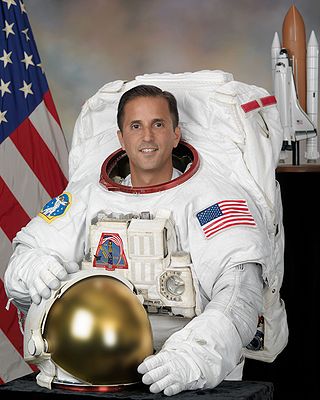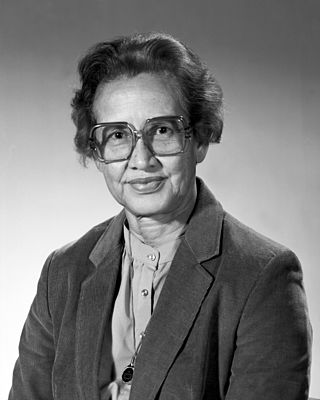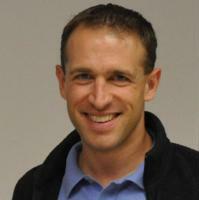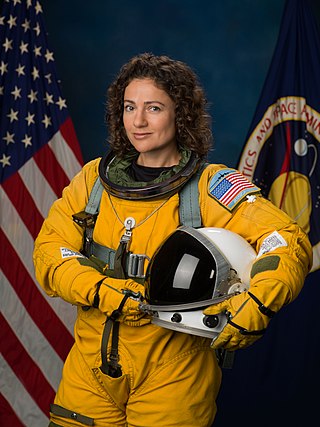
Sharon Christa McAuliffe was an American teacher and astronaut from Concord, New Hampshire who was killed on the Space Shuttle Challenger on mission STS-51-L, where she was serving as a payload specialist.

Robert Brent "Bob" Thirsk, was a Canadian engineer and physician, and a former Canadian Space Agency astronaut. He holds the Canadian record for the most time spent in space. He became an officer of the Order of Canada (OC) in 2013 and was named to the Order of British Columbia (OBC) in 2012.

Bonnie Jeanne Dunbar is an American engineer and retired NASA astronaut. She flew on five Space Shuttle missions between 1985 and 1998, including two dockings with the Mir space station.

José Moreno Hernández is a Mexican-American engineer and former NASA astronaut. He currently serves as a Regent of the University of California.

The University of Alabama in Huntsville (UAH) is a public research university in Huntsville, Alabama. The university is accredited by the Southern Association of Colleges and Schools and comprises nine colleges: arts, humanities & social sciences; business; education; engineering; honors; nursing; professional & continuing studies; science; and graduate. The university's enrollment is approximately 10,000. It is part of the University of Alabama System and is classified among "R1: Doctoral Universities: Very High Research Activity".

Joseph Michael Acabá is an American educator, hydrogeologist, and NASA astronaut. In May 2004 he became the first person of Puerto Rican heritage to be named as a NASA astronaut candidate, when he was selected as a member of NASA Astronaut Training Group 19. He completed his training on February 10, 2006, and was assigned to STS-119, which flew from March 15 to 28, 2009, to deliver the final set of solar arrays to the International Space Station.

Sunita Lyn Williams, nicknamed Suni in the United States and Sončka in Slovenia, is an American astronaut and United States Navy officer who formerly held the records for most spacewalks by a woman (seven) and most spacewalk time for a woman. Williams was assigned to the International Space Station as a member of Expedition 14 and Expedition 15. In 2012, she served as a flight engineer on Expedition 32 and then commander of Expedition 33.

Timothy Lennart "Tim" Kopra is an engineer, a Colonel in the United States Army and a retired NASA astronaut. He served aboard the International Space Station as a flight engineer for Expedition 20, returning to Earth aboard Space Shuttle Discovery on the STS-128 mission on September 11, 2009. He returned to the ISS for the second time in December 2015, as part of Expedition 46 and as the commander of 47.

Gregory Errol Chamitoff is a Canadian-born American engineer and former NASA astronaut. He has been to space twice, spending 6 months aboard the ISS across Expedition 17 and 18 in 2008, and another 15 days as part of STS-134 in 2011. STS-134 was the last of Space Shuttle Endeavour which delivered the Alpha Magnetic Spectrometer and completed the US Orbital Segment.

Andreas Enevold Mogensen is a Danish engineer and ESA astronaut who is best known for being the first Dane to fly in space as part of the European Space Agency's iriss program. Mogensen has also been involved in a number of other space-related projects throughout his career, including working as a test engineer for ESTEC and as a member of the European Astronaut Corps. In addition to his work with the ESA, he has also worked with NASA and other international space agencies. Mogensen returned to space in August 2023 for his second spaceflight to the ISS onboard SpaceX Crew Dragon as the first non-American to serve as a pilot.

Alexander Gerst is a German European Space Agency astronaut and geophysicist, who was selected in 2009 to take part in space training. He was part of the International Space Station Expedition 40 and 41 from May to November 2014. Gerst returned to space on 6 June 2018, as part of Expedition 56/57. He was the Commander of the International Space Station. He returned to Earth on 20 December 2018. After the end of his second mission and before being surpassed by Luca Parmitano in 2020, he held the record for most time in space of any active ESA astronaut, succeeding Italian astronaut Paolo Nespoli, and German ESA astronaut Thomas Reiter, who formally held the record for the longest time in space for any active or retired ESA astronaut.

Creola Katherine Johnson was an American mathematician whose calculations of orbital mechanics as a NASA employee were critical to the success of the first and subsequent U.S. crewed spaceflights. During her 33-year career at NASA and its predecessor, she earned a reputation for mastering complex manual calculations and helped pioneer the use of computers to perform the tasks. The space agency noted her "historical role as one of the first African-American women to work as a NASA scientist".

Christopher E. Gerty is an American aerospace engineer who worked on NASA's Constellation Program. Gerty is an advocate of NASA's Open Government Initiative and is a leading voice on the concept of participatory exploration and collaboration. He has fifteen years of experience working on complex, technology-intense projects at NASA. Gerty served as an aquanaut on the NASA Extreme Environment Mission Operations 13 crew.

Jessica Ulrika Meir is an American NASA astronaut, marine biologist, and physiologist. She was previously an assistant professor of anesthesia at Harvard Medical School, Massachusetts General Hospital, Boston, following postdoctoral research in comparative physiology at the University of British Columbia. She has studied the diving physiology and behavior of emperor penguins in Antarctica, and the physiology of bar-headed geese, which are able to migrate over the Himalayas. In September 2002, Meir served as an aquanaut on the NASA Extreme Environment Mission Operations 4 crew. In 2013, she was selected by NASA to Astronaut Group 21. In 2016, Meir participated in ESA CAVES, a training course in which international astronauts train in a space-analogue cave environment. Meir launched on September 25, 2019, to the ISS onboard Soyuz MS-15, where she served as a flight Engineer during Expedition 61 and 62. On October 18, 2019, Meir and Christina Koch were the first women to participate in an all-female spacewalk.

The NASA Human Exploration Rover Challenge, prior to 2014 referred to as the Great Moonbuggy Race, is an annual competition for high school and college students to design, build, and race human-powered, collapsible vehicles over simulated lunar/Martian terrain. NASA sponsors the competition, first held in 1994, and, since 1996, the U.S. Space & Rocket Center hosts.

Nancy (Crane) Conrad is a teacher, author, publisher, entrepreneur, and public speaker. She is the wife of late astronaut Pete Conrad and Founder and Chair of the Conrad Foundation.

Matthias Josef Maurer is a German European Space Agency astronaut and Materials scientist, who was selected in 2015 to take part in space training.

The Cyprus Space Exploration Organisation (CSEO) is a non-governmental, nonprofit, science organisation, based in Cyprus, with a global scope of service and activities. Its main functions are research and development, space advocacy, and international cooperation in the field of space exploration, astronautics and astronomy. Education and outreach are also an important part of its mission as International Astronomy Education Center.

Jasmin Moghbeli is an American U.S. Marine Corps test pilot and NASA astronaut. She is a graduate of the Massachusetts Institute of Technology, Naval Postgraduate School and Naval Test Pilot School.

Suzanne Mary Imber is a British planetary scientist specialising in space weather at the University of Leicester. She was the winner of the 2017 BBC Two television programme Astronauts, Do You Have What It Takes?.



















